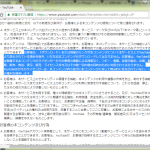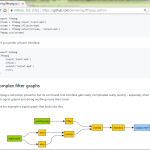同じ処理を何度も必要としそうな上に、PyAV で「Viewing the CaffeNet model’s predictation and its target video at the same time. 」な動画を作る、の巻にはちょっとした問題もあってさ。
かなり自覚的に雑に書いたもんで、PyAV で「Viewing the CaffeNet model’s predictation and its target video at the same time. 」な動画を作る、の巻は Python 3 で動作しなかったし、「末尾での flush」をしてなかったり、「そもそも超絶スパゲッティ」だったり。
スパゲティ的には大して進化はしてないけれど、PyAV で「Viewing the CaffeNet model’s predictation and its target video at the same time. 」な動画を作る、の巻から「オレ的に肝心なとこ」、つまり「機械学習の練習」部分を取り除いて、代わりにその部分を「指定モジュール」から読み出せるようにした「微汎用化スクリプト」:
1 #! /bin/env python
2 import os
3 import sys
4 import argparse
5 import signal
6 import logging
7 from multiprocessing import Process, Queue
8 try:
9 from Queue import Empty
10 except ImportError:
11 from queue import Empty
12
13 from PIL import Image, ImageFont, ImageDraw
14 import av
15
16 def _importmodule(arg):
17 import importlib
18 if ("\\" not in arg) and ("/" not in arg):
19 return importlib.import_module(arg)
20
21 path = arg
22 filename = os.path.basename(path)
23 name, ext = os.path.splitext(filename)
24
25 if hasattr(importlib, "util"):
26 # python 3.x
27 import importlib.util
28 spec = importlib.util.spec_from_file_location(name, filename)
29 module = importlib.util.module_from_spec(spec)
30 spec.loader.exec_module(module)
31 else:
32 # python 2.x
33 import imp
34 magic = imp.get_magic()
35 with open(path, 'r') as file:
36 if file.read(len(magic)) == magic:
37 kind = imp.PY_COMPILED
38 else:
39 kind = imp.PY_SOURCE
40 file.seek(0)
41 module = imp.load_module(name, file, path, (ext, 'r', kind))
42 return module
43
44
45 def _textoverlay(img, txts):
46 # TODO: more flexible: font size, layout of tile
47 fnt = ImageFont.truetype('couri.ttf', 26)
48
49 tmpdctx = ImageDraw.Draw(img)
50 x = 30
51 for txt in txts:
52 txtsz = tmpdctx.multiline_textsize(txt, fnt)
53 osd = Image.new("RGB", (txtsz[0] + 10, txtsz[1] + 10), "white")
54 dctx = ImageDraw.Draw(osd)
55 dctx.multiline_text((5, 5), txt, font=fnt, fill="black")
56 del dctx
57 img.paste(
58 osd,
59 box=(x, 30, osd.size[0] + x, osd.size[1] + 30),
60 mask=Image.new("L", osd.size, 192))
61 x += txtsz[0] + 50
62 del tmpdctx
63
64
65 def _run(args, q):
66 def _IntHandler(signum, frame):
67 q.put("done")
68
69 signal.signal(signal.SIGINT, _IntHandler)
70
71 logging.basicConfig(stream=sys.stderr, level=logging.INFO)
72
73 filter_func = _importmodule(args.image_filter_module).filter_func
74
75 #
76 icntnr = av.open(args.inputmovie_path)
77 ocntnr = av.open(args.inputmovie_path + ".out.mp4", "w")
78
79 ivstrm = next(s for s in icntnr.streams if s.type == 'video')
80 iastrm = next(s for s in icntnr.streams if s.type == 'audio')
81 ostrms = {
82 "audio": ocntnr.add_stream(codec_name=iastrm.codec.name, rate=iastrm.rate),
83 "video": ocntnr.add_stream(codec_name=ivstrm.codec.name, rate=ivstrm.rate),
84 }
85 ostrms["video"].width = ivstrm.width
86 ostrms["video"].height = ivstrm.height
87
88 if args.start_sec:
89 seek_pts_v = int(args.start_sec / float(ivstrm.time_base) + ivstrm.start_time)
90 seek_pts_a = int(args.start_sec / float(iastrm.time_base) + iastrm.start_time)
91 iastrm.seek(seek_pts_a)
92 ivstrm.seek(seek_pts_v)
93
94 def _closing():
95 for typ in ostrms.keys():
96 try:
97 # flush the rest in queue
98 for p in ostrms[typ].encode():
99 ocntnr.mux(p)
100 except av.AVError as e: # End Of File
101 pass
102 ocntnr.close()
103
104 count = 0
105 for packet in icntnr.demux():
106 for ifr in packet.decode():
107 try:
108 r = q.get(block=False, timeout=1/500.)
109 if r:
110 _closing()
111 return
112 except Empty as e:
113 pass
114
115 typ = packet.stream.type
116 ifr.pts = None
117 if typ == 'video':
118 img = ifr.to_image()
119 # --------------------------------------------
120 if count % args.step == 0:
121 img, txts = filter_func(img) #
122 logging.debug(txts)
123 # --------------------------------------------
124 _textoverlay(img, txts)
125
126 ofr = av.VideoFrame.from_image(img)
127 for p in ostrms[typ].encode(ofr):
128 ocntnr.mux(p)
129 if count % args.step == 0:
130 logging.info("count={}".format(count))
131 count += 1
132 else:
133 for p in ostrms[typ].encode(ifr):
134 ocntnr.mux(p)
135 if args.count and args.count <= count:
136 _closing()
137 return
138
139 _closing()
140
141
142 if __name__ == '__main__':
143 parser = argparse.ArgumentParser()
144 parser.add_argument("inputmovie_path")
145 parser.add_argument("image_filter_module")
146 parser.add_argument("--count", type=int, default=0)
147 parser.add_argument("--step", type=int, default=1)
148 parser.add_argument("--start_sec", type=int, default=0)
149 args = parser.parse_args()
150
151 q = Queue()
152 p = Process(target=_run, args=(args, q,))
153 p.start()
154 p.join()
このスクリプトの第二引数 image_filter_module のファイルを例えば「hoge.py」として:
1 def filter_func(img):
2 return img, [repr(img)]
みたいに「filter_func」という名前の「img を受け、結果 img と何らかテキストのリスト」を返すようにしておくと、pyav_imagefilter.py がエラそーに結果 img を使いつつ、返却されたテキストのリストを画像に埋め込む。
元の「機械学習の練習」だった部分を全部この filter_func に詰め込みやがれ、つーわけである。
さて今回のこれ。もちろん「機械学習の練習」を続けることにも目的はあるけれど、それだけでなくて、もっとしょうもないような用途に使いたくて切り出した。
そもそも「フィルタ」が欲しいだけなら、PyAV の(生半可な)紹介で書いておいた通り ffmpeg が内蔵しているフィルタを使う方がひょっとしたら出来ることも多いかも知れず、なのでこの「微汎用化」は、実は実用性という意味では全然大したもんではない。
けど例えば「Pillow や scikit-image の振る舞いを確かめたい」みたいな場合に、「色んな静止画を与えてチマチマ確認する」のって実はかなり大変になりえるわけね。変化が大々的な加工はともかく、そうでない微妙な加工は、ほとんどの場合「入力の性質」に大きく依存し、そしてそういう「都合のいい静止画」を探すことが大変だったりするわけね。これってのはPyAV で「Viewing the CaffeNet model’s predictation and its target video at the same time. 」な動画を作る、の巻のモチベーションと全く同じもので、つまり「だったら動画を入力にしちまえ」てことである。
例えば上の hoge.py をこんなんにしてみる:
1 from PIL import Image
2 from PIL import ImageFilter
3 from PIL.ImageFilter import UnsharpMask
4
5 class _MyF(object):
6 def __init__(self):
7 self._i = 1
8
9 def filter_func(self, img):
10 dimg = img.filter(UnsharpMask(radius=self._i, percent=150, threshold=3))
11 res = dimg, ["radius=%d, percent=150, threshold=3" % self._i]
12 self._i = max(1, (self._i + 1) % 20)
13 return res
14
15 _myf = _MyF()
16 filter_func = _myf.filter_func
こうすれば UnsharpMask の radius の与え方でどう変化するのかを連続的に視覚的に見ることが出来る。(例はほんとうにただの例。意味のあるものではない。)
もちろんこのアプローチには欠点もあって、動画な都合、「lossless」が案外大変だということ。ここでやってるように h264 な mpeg4 にエンコードしてしまう、ということは、あるいはそういう動画を入力にしてしまうということは、「やろうとしてる加工の繊細さ」の邪魔になる場合もある。たとえば dither の与え方による違いを見たい、なんて目的があるなら、そういうのは一枚一枚マジメに静止画与えて確認した方がいい。そうでないと騙される可能性がある。











